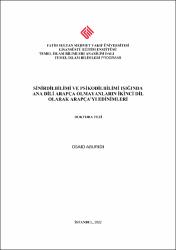| dc.contributor.advisor | Arslan, Ahmet Turan | |
| dc.contributor.author | Aburidi, Osaid | |
| dc.date.accessioned | 2023-03-17T14:12:28Z | |
| dc.date.available | 2023-03-17T14:12:28Z | |
| dc.date.issued | 2022 | en_US |
| dc.identifier.citation | ABURİDİ, Osaid, Sinirdilbilimi ve Psikodilbilimi Işığında Ana Dili Arapça Olmayanların İkinci Dil Olarak Arapça’yı Edinimleri, Fatih Sultan Mehmet Vakıf Üniversitesi Lisansüstü Eğitim Enstitüsü Temel İslam Bilimleri Anabilim Dalı Temel İslam Bilimleri Programı, Yayımlanmamış Doktora Tezi, İstanbul 2022. | en_US |
| dc.identifier.uri | https://hdl.handle.net/11352/4365 | |
| dc.description.abstract | Bu çalışma, sinirdilbilim ve psikodilbilim ışığında ana dili Arapça olmayanların ikinci dil olarak Arapçayı edinimlerini ele almaktadır. Dolayısıyla bu çalışma, Arapçayı ikinci dil olarak edinme ve öğrenme sürecinde karşılaştığımız sorunları çözmeye odaklandığımız, uygulamalı dilbilime dayalı bilimsel bir çalışmadır. Ayrıca bu çalışma, Arapçayı ikinci dil olarak öğrenmenin ve edinmenin modern bir yönüne ışık tutmayı amaçlamaktadır. Bu çalışma giriş, sonuç ve araştırma önerileri dışında, dört bölümden oluşmaktadır.
Birinci bölümdeki konuları “Uygulamalı Dilbilim ve Dil Edinimi” başlığı altında işledik. Bu bölümü iki kısıma ayırdık. Birincisi uygulamalı dilbilimin tanımı ve bu bilimin geçmişteki ve günümüzdeki gelişiminin yanı sıra bu bilimden geleceğe yönelik beklentilerin bir sunumudur. İkincisi ise dil edinimi, sinirdilbilim ve psikodilbilim arasındaki ilişkiyi ele almakta, ayrıca dil edinimi ve öğrenme arasındaki ayrımı içermektedir.
İkinci bölümde, “Beyin ve Sinirdilbilim ve Dil Olayıyla İlişkisi” başlığı altında, sinir sisteminin anatomik temellerinden bahsettik. Aynı zamanda beynin ikiye bölünmesini ve dil ile ilişkisini, ardından dilin beyindeki konumunu ve dilin beyinde nasıl işlendiğini aktardık. Bu bölümde dil bozuklukları ve iki dillilik gibi beyinle ilgili dilsel zorluklardan ve zihnin dili algılama mekanizmasından (sesler, kelime dağarcığı ve yapılar) bahsederek bu bölümü sonlandırdık.
Üçüncü bölüm, “Psikodilbilim ve Dil Fenomeniyle İlişkisi” başlığı altında, psikodilbilimsel yönelimlerden bahsederek başladığımız ve ardından birinci dilin edinimini sunduğumuz bölümdür. Burada önce birinci dilin edinimini açıklayan davranışsal eğilimleri, ardından da psikodilbilim ışığında ikinci dil edinimini tanıttık. Ayrıca ikinci dil edinimini etkileyen psikolojik faktörleri ve dil öğretim yöntemlerini açıkladık. Ardından ikinci dilin edinilmesiyle hafızanın ilişkisini ve son olarak da ikinci dilin unutulmasından bahsederek bu bölümü sonlandırdık.
Dördüncü bölümde konuları “Ana Dili Arapça Olmayan Öğrenciler İçin Nesnel Dil Sisteminin Düzeyleri” başlığı altında işledik. Bu bölümde öğrencilerin üretimiyle ilgili üç seviyeden bahsettik; ses düzeyi, yapısal düzeyi ve anlamsal düzey. | en_US |
| dc.description.abstract | This study addressed the acquisition of Arabic by non-native speakers in the view of neurolinguistics and psycholinguistics. It is thus a scientific study based on applied linguistic sciences, through which we work to solve the problems facing us in the acquisition and learning process of Arabic as a second language. In addition, this study aims to highlight a modern aspect of learning and acquisition Arabic as a second language.
The study, therefore, required an introduction, a conclusion, and four sections, as well as the recommendations that we have attached at the end of the study.
The first section is entitled "Applied Linguistics and Language Acquisition" it is divided into two parts; the first part is a presentation of the definition of applied linguistics and the evolution of this science in the past and present, as well as of future expectations for this science, The second is the relationship between language acquisition, neurology, and psychology, also a distinction between acquisition and learning.
The second section of this study is entitled "Brain and Neurology and Their Connection to the Linguistic Phenomenon." In it, we talked about the anatomical foundations of the nervous system, and we presented the division of the brain into two halves and its relationship with the language, followed by the position of the language in the brain and how to process the language in the brain, we then concluded this section by talking about the mechanism in which the mind is aware of language: Sounds, vocabulary, and combinations.The third section is entitled (Psychological Linguistics and its Relationship to the Linguistic Phenomenon), in which we started by mentioning the psychological-linguistic schools, then we presented the acquisition of the first language, and the behavioral trends that explain the acquisition of the first language, then we referred to the acquisition of the second language in the light of psycholinguistics, and we mentioned the psychological factors influencing the acquisition of the second language, then we came to the methods of teaching languages, and after that, we showed the relationship of memory to the acquisition of the second language and we concluded this section by talking about forgetting the second language.
As for the fourth section of this study, it comes under the title (Levels of the Objective Linguistic System for Learners of Arabic Language of Other Languages), in which we mentioned the three levels related to the production of learners, namely the phonemic level, the structural level, and the semantic level. | en_US |
| dc.language.iso | tur | en_US |
| dc.publisher | Fatih Sultan Mehmet Vakıf Üniversitesi, Lisansüstü Eğitim Enstitüsü | en_US |
| dc.rights | info:eu-repo/semantics/openAccess | en_US |
| dc.subject | Uygulamalı Dilbilim | en_US |
| dc.subject | İkinci Dil Edinimi | en_US |
| dc.subject | Sinirdilbilim | en_US |
| dc.subject | Psikodilbilim | en_US |
| dc.subject | Arapça Öğretimi | en_US |
| dc.subject | İkinci Dil Öğretimi | en_US |
| dc.subject | Applied Linguistics | en_US |
| dc.subject | Second Language Acquisition | en_US |
| dc.subject | Neurolinguistics | en_US |
| dc.subject | Psycholinguistics | en_US |
| dc.subject | Arabic Language Education | en_US |
| dc.subject | Second Language Education | en_US |
| dc.title | Sinirdilbilimi ve Psikodilbilimi Işığında Ana Dili Arapça Olmayanların İkinci Dil Olarak Arapça’yı Edinimleri | en_US |
| dc.title.alternative | Acquisition of Arabic as a Second Language for Non-Native Speakers in the View of Neurolinguistics and Psycholinguistics | en_US |
| dc.type | doctoralThesis | en_US |
| dc.contributor.department | FSM Vakıf Üniversitesi, Lisansüstü Eğitim Enstitüsü, Temel İslam Bilimleri Ana Bilim Dalı | en_US |
| dc.relation.publicationcategory | Tez | en_US |
| dc.contributor.institutionauthor | Aburidi, Osaid | |



















